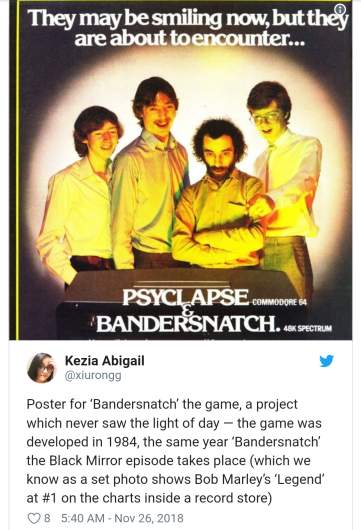
Bandersnatch
With Black Mirror releasing its Bandersnatch movie today, you may be wondering what Bandersnatch means and the name’s history. Although Bandersnatch isn’t technically a real name, it does refer to a fictional character in Lewis Carroll’s 1872 novel Through the Looking-Glass, and it’s also the name of a game that almost became reality in the 1980s. Read on for more details and to see a documentary about the game.
Bandersnatch was mentioned in Carroll’s 1874 poem The Hunting of the Snark. Carroll describes the Bandersnatch as being ferocious and fast, with a long neck and powerful jaws. You can read the full poem about the Bandersnatch on Wikipedia here. Bandersnatch also appears in other media, TV shows, and movies.
Bandersnatch also just happens to be the name of a game that was never actually released, but was developed in 1984 by a British company, no doubt inspiring the name of this movie:
Eventually the rights to the Bandersnatch game were sold and the game became Brataccas — a game about a genetic engineer trying to create an elite soldier. According to Wikipedia: “Brataccas is believed to be the remains of the much-hyped vaporware project Bandersnatch, which was partially developed by Imagine Software. Having been talked about in the press for some time before finally emerging, Brataccas saw considerable coverage in the computer press. It was generally reviewed poorly due to significant control problems, although the graphics were widely praised.”
Here’s a documentary about the holiday rush that went into producing the Bandersnatch game, and why it failed.
Bandersnatch was originally going to be one of six Megagames created by Imagine Software. The games were going to push hardware boundaries of the 1980s and be released with a hardware add-on for computers. Imagine collapsed and the games became vaporware, with Bandersnatch being acquired by Finchspeed. Why did Imagine Software collapse? It was accumulating debts in 1983 and then a documentary showing its collapse didn’t help. It was ultimately unable to raise the money needed to pay its debts.
